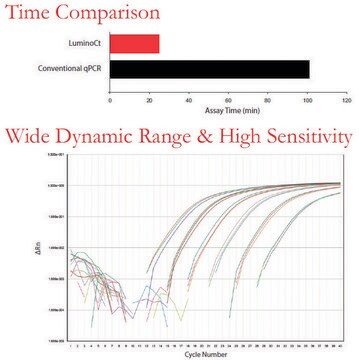FSSGMMRO
Roche
FastStart SYBR Green Master
sufficient for 500 reactions, sufficient for 5000 reactions, suitable for qPCR, suitable for RT-qPCR
About This Item
Recommended Products
usage
sufficient for 500 reactions
sufficient for 5000 reactions
Quality Level
feature
dNTPs included: no
hotstart
manufacturer/tradename
Roche
packaging
pkg of 500 x 20 μL reactions (04673484001)
pkg of 5000 x 20 μL reactions (04673492001)
technique(s)
RT-qPCR: suitable
qPCR: suitable
input
purified DNA
detection method
probe-based
Related Categories
General description
FastStart™ SYBR® Green Master is a ready-to-use hot start reaction mix without ROX for quantitative polymerase chain reaction (qPCR) and reverse transcription (RT)-qPCR on real-time PCR systems other than the LightCycler® instruments. This master mix simplifies the preparation of reactions for DNA detection and analysis. In combination with a real-time PCR instrument, suitable PCR primers, and a hydrolysis probe, FastStart™ TaqMan® Probe Master allows very sensitive detection and quantification of defined DNA sequences.
SYBR® Green I is a DNA double-strand-specific dye. During each phase of DNA synthesis, the SYBR® Green I dye, included in the reaction mix, binds to the amplified PCR products. The amplicon can be detected by its fluorescence.
Hot start protocols have been shown to significantly improve the specificity, sensitivity, and yield of PCR. Heat-labile blocking groups on some of the amino acid residues of FastStart™ Taq DNA Polymerase make the modified enzyme inactive at room temperature. Therefore, there is no elongation during the period when primers can non-specifically bind. The FastStart™ Taq DNA Polymerase is activated by removing the blocking groups at a high temperature (i.e., a pre-incubation step at +95°C).
The FastStart™ SYBR® Green Master can be used for the amplification and detection of any DNA or cDNA target, including those that are GC- or AT-rich. However, you would need to adapt your detection protocol to the reaction conditions of the particular real-time PCR instrument used and design specific PCR primers for each target.
Combine this master mix with our Transcriptor First Strand cDNA Synthesis Kit to achieve excellent results in two-step qRT-PCR.
Application
- in quantitative polymerase chain reaction (qPCR) for adeno-associated virus (AAV) titre quantification
- in qPCR to determine the expression level of different Col6a1-3 genes relative to glyceraldehyde 3-phosphate dehydrogenase (GAPDH)
- in quantitative real-time polymerase chain reaction (qRT-PCR) of G protein-coupled estrogen receptor-1 (GPER) mRNA
- in qRT-PCR for gene expression studies
Use the FastStart™ SYBR® Green Master with any real-time qPCR instrument other than the LightCycler® Instruments.
Features and Benefits
- Improve PCR sensitivity and specificity:
- Avoid over-estimation of qPCR results:
- Amplify and detect a broad range of DNA or cDNA targets:
- Use any real-time PCR instrument other than the LightCycler® Instruments:
- Save time and effort in qPCR preparation:
- Prevent false positives resulting from carryover contamination:
Components
Quality
Other Notes
In principle, the FastStart SYBR Green Master can be used for the amplification and detection of any DNA or cDNA target, including those that are GC- or AT-rich. However, for each target, you would need:
- to adapt your detection protocol to the reaction conditions of your real-time PCR instrument, and
- design specific PCR primers for the target.
See the Operator′s Manual of your real-time PCR instrument for general recommendations.
Two forms available
The master mix is available in two forms – one that contains the ROX reference dye and one without ROX.
Preventing carryover contamination
This master contains dUTP, which will be incorporated into PCR products to help prevent false positives resulting from carryover contamination. In subsequent PCRs, you can add Uracil-DNA Glycosylase to degrade any uracil-containing carryover contaminants (amplification products from previous PCRs).
qRT-PCR
Combine this master mix with our Transcriptor First Strand cDNA Synthesis Kit for two-step qRT-PCR. This kit gives excellent results and works efficiently with all real-time PCR instruments.
Legal Information
Storage Class
12 - Non Combustible Liquids
wgk_germany
WGK 1
flash_point_f
does not flash
flash_point_c
does not flash
Choose from one of the most recent versions:
Certificates of Analysis (COA)
It looks like we've run into a problem, but you can still download Certificates of Analysis from our Documents section.
If you need assistance, please contact Customer Support.
Already Own This Product?
Find documentation for the products that you have recently purchased in the Document Library.
Customers Also Viewed
Articles
Watch these videos to learn how real time or quantitative PCR (qPCR) works and the benefits of both the SYBR Green-based and probe-based methods of qPCR assay.
PCR master mix simplifies PCR/RT-PCR with components like DNA polymerase, dNTPs, MgCl2, and buffer, available commercially or DIY.
The purpose of Hot Start PCR is to inhibit the PCR reaction in order to reduce nonspecific amplification, prevent the formation of primer dimers, and increase product yields.
Related Content
Polymerase chain reaction (PCR) is a technique for amplifying nucleic acid molecules and is commonly used in many applications, including RT-PCR, hot start PCR, end point PCR and more.
Our team of scientists has experience in all areas of research including Life Science, Material Science, Chemical Synthesis, Chromatography, Analytical and many others.
Contact Technical Service










